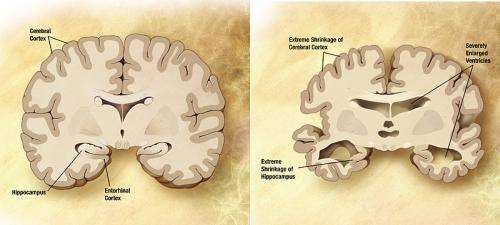Diagram of the brain of a person with Alzheimer's Disease. Credit: Wikipedia/public domain.
Researchers at the University of Kentucky's Sanders-Brown Center on Aging have completed a study that revealed differences in the way brain inflammation—considered a key component of AD— is expressed in different subsets of patients, in particular people with Down syndrome (DS) and AD.
People with Down syndrome have a third copy of Chromosome 21, and that chromosome is the same one responsible for the production of a molecule called amyloid precursor protein. Amyloid overproduction can lead to brain plaques that are a cardinal feature of Alzheimer's, so it is not surprising that nearly 100 percent of people with Down syndrome develop Alzheimer's disease pathology in their brain by the time they are 40.
"People develop Alzheimer's disease at different ages, but it's typically in their 60s, 70s, or 80s," said Donna Wilcock, an assistant professor at the Sanders-Brown Center on Aging and principal investigator for the study. "It's a little easier to study Alzheimer's disease in Down syndrome because of the predictability of the age when adults with DS develop signs of the disease."
In Wilcock's study, some interesting data emerged that will shape the way scientists look at AD as manifested in various subsets of the population. Using brain autopsy tissue from a group of people—some with DS/AD, some with AD alone, and some healthy, Wilcock and her team were able to determine differences in the way neuroinflammation was expressed in people with DS.
In previous studies where Wilcock and her colleagues identified different types of inflammation in AD brains,, two families of inflammatory markers—called M1 and M2a—were each present to varying degrees in the sample population representing early AD cases, indicating a notable level of heterogeneity in the way the AD disease process begins in the brain. But in the late-stage AD cases, there was a high degree of homogeneity with high levels of the markers M1, M2 and M2c.
"If you think of it in terms of a roadmap, there is almost always more than one way to get from Point A to Point B, and that seems to be the case in disease progression as well," said Wilcock.
In this most recent study, the team found that the inflammatory response in DS/AD brain tissue was significantly greater than that in tissue from AD patients. Further, there was an elevated level of markers for M2b,that was not replicated in tissue from sporadic (i.e. ideopathic) AD cases.. In other words, AD in the DS brain had a very different neuroinflammatory profile than AD in people without DS.
"It has been generally assumed that AD presents the same way in people with Down syndrome as it does in people without DS, but our work demonstrates that this is not the case," said Wilcock. "This will have important implications for the study of AD treatments, as some treatments might be effective with people without DS but not those with DS, and vice-versa."
Wilcock's work has been published online in the Neurobiology of Aging. This study was part of a larger DS Aging study at the Sanders-Brown Center on Aging funded by NIH/NICHD (Head and Schmitt), and was also funded by a research grant awarded to Dr. Wilcock through a partnership between the Alzheimer's Association, the Global Down Syndrome Foundation and the Linda CRNIC Institute for Down syndrome.
Journal information: Neurobiology of Aging
Provided by University of Kentucky




















